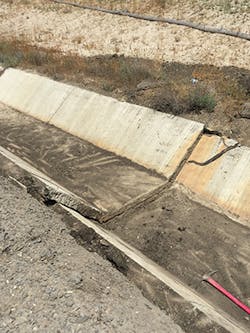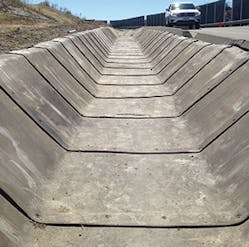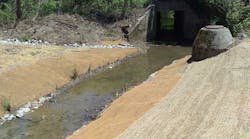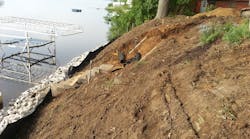A lot of good things have been said about Frank R. Bowerman Landfill in Orange County, CA. It has recently powered up a major methane-to-electrical generation station to capture and reuse landfill gasses that some waste operations would be content just to burn off as waste. According to Robert Sjoquist, president of Soils Solutions Inc., the landfill also has a “very aggressive recycling operation.” He says the facility welcomes almost every kind of waste. And most impressive, he says, “They are very people centric.” In addition to clean-up days in the surrounding neighborhood, the landfill is interactive with the community, welcoming visitors who would like to come by and better understand the landfill’s programs and operations. “It’s a very forward-thinking facility,” says Sjoquist. Kevin Hanson of Orange County Waste and Recycling says he is proud that the facility has been recognized as one of the best landfills in the US, and he also notes it is one of the top facilities in terms of tonnage accepted per day.
Nonetheless, says Hanson, the one thing consistent with all landfills is change. Adding methane production and electrical generation to Bowerman Landfill’s operations ushered in big change on the positive side, but in addition, he notes, “We constantly have new regulations coming up and we have to keep on top of them.”
There is constant change in the physical realm of a landfill as well. Much of that change revolves around the effects of gravity on the movement of land and water. Hanson says two of the most challenging ongoing and continuous changes at Bowerman Landfill, or any landfill, involve this movement of land and water.
Depressed Over Trash
“We found we had serious differential settlement issues where soil is either on top of native soil or on top of trash,” explains Hanson. Although, he says operators may have a rough idea where the buried trash is, the exact location often doesn’t become clear until “what used to be a slope” gets flattened out into “a depression” by the force of decomposition and gravity working variably on soil and buried trash. When that happens, any infrastructure situated on the collapsing earth is subject to deformation and fracture. In this way, differential settlement doesn’t just threaten to expose trash, it also interferes with efficient drainage. According to Hanson, this settlement can become a major problem when it begins to affect drainage infrastructure.
Concrete-faced drainage ditches on the surface of Bowerman Landfill, designed to carry stormwater runoff, had been displaced by differential settlement along the slopes. There was the potential that cracks and voids appearing at junctions and fractures in the trapezoidal concrete drains could be undermined during heavy rains, says Hanson. “Water can get under the concrete channel bed liners and cause them to flip, allowing the water to directly impact the slope. The biggest issue is, if the channel fails, water will erode the soil and get into the trash. And with a heavy enough rain it could carry contaminants, and it could expose a creek to pollutants.”
What Bowerman needed was a system to repair and reinforce the drainage channels that would be resilient to the unpredictable effects of differential settlement. Hanson says one of the worst things about the settlement issue is that “it just never stops.” He says that if the landfill operators made the decision to simply reline the ditches in the traditional manner, by merely filling the cracks with fresh concrete, it probably wouldn’t hold very long. “We were afraid we’d have to redo it in two years,” he says. And the cost would be high.
Sjoquist, who is also the supplier of Concrete Cloth from Milliken Infrastructure Solutions, hosted a lunch-and-learn session on the product with Geosyntec, the civil engineering firm providing management-consulting services to the Bowerman Landfill. Echoing Hanson’s concern, he says, “The thing with landfills is they are always sinking. The old way to deal with it was to use steel, concrete, and rebar to reline the drainage infrastructure.” However, he says, “Concrete Cloth’s compressive strength is three times that of Portland cement, and it can give under stress and meld to an area. If it does crack, it doesn’t crack all the way through, making it earthquake resistant,” a quality of particular importance in California. Furthermore, he says, because it is so economical, if it is disturbed by settlement, “we can do it again.”
Repair Beats Replacement
In addition to the cracking channels, says Sjoquist, Bowerman Landfill’s management was at a complete loss as to how to economically repair a collection of corroding stormwater drainage pipes buried hundreds of feet within the landfill’s slopes. “Pulling those culverts out and replacing them would cost millions of dollars, and to go in and try to re-sleeve them, which is the conventional way to repair a faulty underground fixture, is also very expensive,” he says. One additional complication: “These things curve a little bit as they go up the hills, and you have to have a perfectly straight shot for those slip tube pipe fix kits to work.”
A few weeks after Sjoquist delivered the presentation on Concrete Cloth, Geosyntec invited him to meet and conduct a field demo for the landfill operators at a Caltrans site where the product was being deployed. After witnessing the easy installation, the landfill operators asked for a materials quote for the application at the Bowerman Landfill. During the subsequent bidding on the project, says Sjoquist, they were astonished when “the materials cost of using Concrete Cloth on the project came in at an estimate of about one-tenth of what they had expected to pay for just lining the culverts, with a much longer life expectancy.” He adds, “What we’re doing is saving them a ton of money on infrastructure.”
The 420-foot-long concrete trapezoidal drainage channels were re-veneered. After using a grout to fill in the cracks and voids that differential settlement had generated, explains Hanson, crews placed the Concrete Cloth over the existing channel. It was locked in with an anchor trench, backfilled with soil on one side, and secured with a ramset nail on the other. A 6-inch-wide anchor trench “ties the installation in at the top of the original channel, and that is backfilled with concrete so water can’t get underneath either the Concrete Cloth or the actual channel lining.”
The future parking area at Rock City
Al Gordon, project manager for Bowerman Landfill, says, “The Concrete Cloth acts as a liner. The water just flows right over it. The trick is to make sure you saturate it very well so you get a good cure for the concrete. Once that’s done, it’s a very simple application.”
“You lay it down and hold it in place with percussive anchors, then wet it with water and it starts to cure,” says Sjoquist. “It starts to cure within 24 hours, and within 48 hours it’s twice as strong as a sidewalk.”
In a separate application, Bowerman Landfill also used Concrete Cloth to rejuvenate several 330-foot-long, 66-inch-diameter metallic culverts that ran underground, which also provided drainage for the landfill. These conduits had experienced severe corrosion and deterioration from the inside out, with erosion from uncontrolled water cutting out voids from the fill supporting the pipes. After backfilling the voids, explains Sjoquist, “You go in, cut off the rusted edges of the pipe and put Concrete Cloth on it, add 30 to 50 years of structural longevity, and end up with a shape that’s clean.”
He says, “The pipe bedding was backfilled with a controlled low-strength material.” Starting at the bottom of the slope, the Concrete Cloth went in “crossways on the floor of the culverts in 60-inch-wide swaths going up the sides, past the highest high-water mark that’s ever been recorded.” Workers cut sheets of the material from the rolls and hand-carried them into the culverts, a job Sjoquist says would be challenging for him personally, conceding his discomfort with enclosed spaces. However, other than a tolerance for the working environment, the job required little specialized skill. Workers simply lay the sheets down with a strategic overlap of 4 to 6 inches, starting at the bottom and working their way up through the conduit. Using seven, bulk rolls CC8 material—a Concrete Cloth with a thickness of 8 millimeters—the total job involved around 10,000 square feet.
Sjoquist says the advantage in using Concrete Cloth to line a culvert is that it creates a protective wall that is very thin but very strong, resulting in minimal impact on the conveyance’s flow capacity.
Concrete Cloth is easy to apply, he notes. “It comes on a roll that looks like a filthy piece of carpet, and in three different thicknesses. Depending on the slope, the customer decides whether to install it in a crosshatch or in perpendicular runs.”
Gordon says, “We were impressed with this product; once you get the hang of it, it installs easily. We could see ourselves using it on an open-cut trench but we just haven’t had the opportunity to do it yet.”
Of the good reviews the landfill has received for its innovative approaches to both infrastructure and service, Sjoquist notes, “It’s the first landfill I’ve ever been to where you feel cleaner when you come out than when you went in.”
Fresh Parking Without Paving Paradise
Rock City first got its name when a nurse, following the conflict and the casualties of the American Civil War, found herself among the stone outcroppings in the landscape of the Lookout Mountain region of Tennessee. “It was like a city of rocks and they, to her, looked like streets and alleyways,” says Bill Chapin, owner of Rock City Inc., a botanical garden and popular tourist attraction ensconced in this scenic natural setting. Since the nurse’s visit more than a century and a half ago, Rock City has been visited by millions of nature lovers, vacationers, and sightseers. They come not only to view the beautiful and unusual rock formations, but also to enjoy attractive manicured gardens his firm maintains, the natural beauty of the regional landscape, and the colorful foliage at the change of the seasons. He says that has brought overflow volumes of traffic for at least 20 days of the year during holiday seasons and particularly in the fall when the mountainsides gleam with color.
Although Chapin concedes that the tourism business has its ebbs and flows, coinciding with economic conditions, an uptick in tourism in the Chattanooga area over the past eight years had begun to put pressure on the neighborhood where Rock City is located. With the rising popularity of the attraction, Rock City resorted to parking guests’ vehicles on the streets in the neighborhood—”and our neighbors complained,” he says.
The company however, owned a parcel of land in the neighborhood that Chapin believed could be converted to parking during seasons of high traffic. He describes the area as a 1.5-acre grassy meadow, which, by coincidence, had been adapted by the neighborhood residents for use as a park and children’s play area.
With a need for nearly 150 additional spaces on a seasonal basis, the company-owned lot looked like a perfect solution for Rock City’s parking woes. However, Chapin believed, and conversations with area residents confirmed, that taking over the cherished recreation area for parking would rankle neighbors just as much as had the visiting tourists occupying the parking spots in front of residents’ homes. Chapin envisioned a compromise. Rock City would indeed utilize the previously undeveloped space that it owned for parking during peak periods; however, to preserve the park-like atmosphere to which residents had become accustomed, the facility would forego putting any kind of pavement over the field.
Chapin says his calculations, based on traffic flow, indicated that the new parking spaces the lot could offer during peak busy periods would pay off even after figuring in the added expense of laying a creative alternative to pavement. Chapin selected GrassProtecta from Berry Plastics to achieve this objective. It is laid down on top of turf grass and allows the grass to grow through it, thriving in spite of being periodically overrun by vehicles. GrassProtecta does this by distributing the weight of the autos across the surface of the plastic mesh and protecting the root zone of the grass to maintain the natural look and feel of manicured parkland.
Although the site selected for seasonal overflow parking was fairly flat prior to installation, with most of its slopes under 5%, John Brown, senior landscape architect with Barge Waggoner Sumner & Cannon Inc., who designed the project, says installation began in July with a bit of excavation and fill to smooth out the rough spots where slopes were just a little too steep for parking. That process left a few rock outcroppings to be addressed and smoothed over with an additional application of topsoil, in some instances from 2 to 4 feet deep, to cover the jutting rock. Filtrexx FilterSoxx, used during construction, kept sediment from the site and away from a wet-weather conveyance that passed between the temporary parking area and the adjacent paved parking lots.
A bridge connects the two segments of the parking area.
After grading the site, spreading the topsoil, and laying the sod, crews could “roll out” the GrassProtecta with ease. Because it is delivered in rolls rather than squares, says Brown, “It’s more economical to put down than other products designed as turf protectors.” He adds that unlike some other products, “GrassProtecta goes down after the sod,” which allows it to provide more comprehensive protection for the root zone.
According to Chapin, the GrassProtecta installed on the field will help prevent rutting with the passage of cars and will help maintain the pleasant natural aesthetic of the property. One of the highlights of the seasonal parking lot, he says, will be a bridge connecting the two parking areas and passing over the wet-weather conveyance that divides the parking areas. By next spring and summer, he says, “the driving surface of the bridge will also be covered with sod and GrassProtecta and it will be exceptionally beautiful when complete.” Although it has not yet experienced a full growing season, says Chapin, “The grass is growing great. We added an irrigation system to the whole acre and a half of parking, and the grass has camouflaged the GrassProtecta so that it looks like a soccer field.”
Journey to the Center of the City
Connecting the communities of the New York metro area will take a bit longer than one good growing season, and it will also take more than bridges. In addition to its already-famous bridges, New York is also digging tunnels to move its millions of visitors and residents around with comfort and efficiency.
The project is part of one of the largest transportation infrastructure initiatives currently underway in the US. It includes more than 11 miles of tunneling that encompasses work in multiple locations in Manhattan, Queens, and the Bronx. The vast majority of the project is in an urban setting, making material delivery difficult due to severe space constraints and the scope of the job.
A section of the project called the East Side Access, connecting the Long Island Rail to New York City’s MTA, will create a series of tunnels underneath the city streets of Queens. One of the early steps in digging and embedding the transit tunnel network, starting at 150 feet below street level, was to dig a hole 67 feet deep to provide a subterranean access platform for staging equipment and personnel during the tunnel construction. In layman’s terms, it’s a huge hole in the earth used to access or to connect two tunnel lines underground; in the subsurface transport industry, it’s known as a bellmouth.
With a bustling cityscape above it to support, the construction of this bellmouth would require a 67-foot-high, mechanically stabilized earth (MSE) temporary retaining wall with a 10-year design life to span the construction phases of the overall project.
“It’s one of the largest infrastructure projects in the country,” says Craig Bell, regional manager for Strata Systems, who provided onsite assistance. “They cleared the entire city block. They keep the traffic live on the streets above, and created an access point that gets deeper and deeper as it approaches the East River,” resulting in a platform to support “a working area perpendicular to the tubes.” The tubes for the transit vehicles, he notes, will eventually be situated several hundred feet deeper.
Explaining the importance of a reliable geogrid structure to support this work, Bell says, “A lot of the area is filled material. We’re talking about an area that was built up—elevated, essentially. There is bedrock as well, and there was some blasting, but it is primarily fill.”
A Different Kind of Wall
The Strata Wall was built to shore up the boundaries of the nearly 70-foot hole incorporated hot-dip galvanized 4×4 wire form facing elements, with geotextile and geogrid facing wrap. While the original project specifications and plans called for a steel-reinforced wire wall, that option would have been both cost prohibitive and difficult to construct given the tight working area. Materials had to be delivered with a crane into the hole where the MSE wall was constructed. Because StrataGrid is rolled and easy to handle, material transport and delivery are much more efficient, which also helped with the strict time and budget constraints on the project.
The fill specified for backing the geogrid consisted of 1-inch-minus select, well-draining material, which Bell describes as a mixture of small rock and fines. “It’s a good material to work with. It compacts well. It’s easy enough to spread around.” He cautions, “With geogrid reinforcement you want a material that’s well graded, but not too big. Anything bigger than 2 inches is not a preferred material for geogrid. It can be done, but it’s not ideal.”
There were real challenges from a constructability standpoint with regard to placement of the materials, says Bell. However, the builder, Tutor Perini Corporation, employed a novel solution. “They had a loader on street level feeding the fill material through a conveyor that led to a chute that dropped it a hundred feet down, and they would guide the chute in order to fill the area. Then they would spread and compact the material over the geosynthetic. They’d do that, lift, and then come back and do the next one, and the next one, and the next one. That’s how they got the area all the way up to 67 feet tall.”
Bell describes building the MSE wall as a sequential process repeated many times until it reaches the desired height. “They’ll place the wire form, they’ll place the primary reinforcement, which is our StrataGrid 700, and then they’ll place the high-survivability geotextile face wrap at the wire form. After the structure is filled, all you really see is the wire form and the geotextile.” Although in appearance it is very different from a geogrid application used to reinforce a slope, “the technology is virtually the same,” says Bell. For this application, he explains, “We just steepened up that structure to vertical, or near vertical—in this case it’s about a 3-degree setback.”
The wall’s designer, Chad Clark, principal with Clark Geotechnical LLC, says, “The quality of Strata’s products and services allowed us to design the temporary retaining wall system with confidence. This was important to us, given the significance of the overall project and critical nature of the temporary wall. And the structure is likely one of the tallest single-height MSE temporary walls constructed in the US using welded-wire form facing and geogrid reinforcement.”
As with many geosynthetic applications, the East Side Access’ bellmouth temporary MSE wall will soon be hidden from public view. With the continued progress of the overall transportation infrastructure initiative, once the tubes are constructed, the hole will be filled, and new development—a constant in the City of New York—will likely be constructed on the site. Thinking nothing of the massive wall and all the effort that has gone into it, the transit riders, pedestrians, and motorists passing through Queens will continue to enjoy life in the city that they love.
Whether supporting society by reinforcing efficient landfill operations, supporting neighborhoods by preserving parklands and recreation, or undergirding massive urban infrastructure improvements—and whether they are seen or hidden from view—geosynthetic materials and products are quietly inspiring innovation all across the country.









